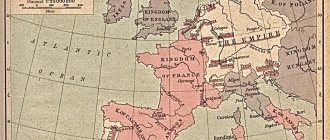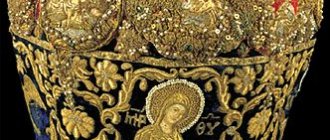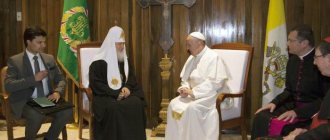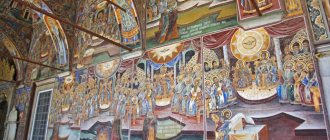CLEMENT VII
The Italian wars, which by this time had grown into open confrontation with the French. cor. Francis I and Emperor Charles V, who was also occupied by Spain. throne, still determined the policy of the Papal See. Although K. was elected pope with the support (including financial) of the imp. Charles V, the pontiff refused to renew the treaty of alliance concluded by Pope Adrian VI (expired in September 1524), and therefore he had to secretly pay the former. significant sums of money to the allies, and also to leave in Lombardy part of the mercenary detachments financed from the papal treasury who fought on the side of the Spaniards. He initiated negotiations to end hostilities (Dec. 1523 - June 1524). Having once again rejected the proposal to extend the alliance treaty with the emperor, K. first concluded a secret agreement with France and Venice on “peace and friendship” (December 12, 1524), and then ratified it (January 2 or 4, 1525). This agreement was supposed to seal the marriage of the pope's niece, Catherine de' Medici, and the son of Francis I, b.d. French cor. Henry II (1547-1559). The situation changed dramatically after the Battle of Pavia (February 24, 1525): the French were defeated, the king was captured, and almost everything was Italian. The states came under the control of the emperor, and Rome found itself in the power of the noble families of Orsini and Colonna. The Pope tried to attract the English to an alliance against the Emperor. cor. Henry VIII, but then abandoned this idea. In March 1525, he began negotiations with the Viceroy of Naples, Charles de Lannoy, and in exchange for cash payments, he obtained a promise that the imp. troops were not introduced into the papal possessions (the agreements reached by April 1 were not ratified by the emperor).
Clement VII, Pope of Rome. OK. 1526 Artist. S. del Piombo (Capodimonte Museum, Naples) Clement VII, Pope. OK. 1526 Artist. S. del Piombo (Capodimonte Museum, Naples)
On the initiative of Queen Regent Louise of Savoy, who ruled France while Francis I was in captivity in Madrid, negotiations were held with the Papal See and Venice to create an alliance against the emperor. Meanwhile, as a result of a coup (October 14, 1525), the Spaniards seized power in Milan. K. declared his categorical disagreement with the Duchy of Milan and the Kingdom of Naples being in the hands of one ruler. The emperor seemed ready to make concessions, and K., under the influence of his advisers, promised that for 2 months he would not take any measures against the emperor (agreement dated December 12, 1525). And although later, after the signing of the Treaty of Madrid between Spain and France (Jan. 14, 1526), it was the pope who insisted that the French. the king could not fulfill his conditions, because he agreed to them while in captivity; trust in the pope as an ally was probably lost. On May 22, 1526, an agreement was concluded to create an alliance against the emperor (the so-called League of Cognac), which united the French. king, Pope, Duke of Milan (having conquered Milan in 1526, Charles V made Francesco II Sforza Duke of Milan), Venice. In accordance with allied obligations, K. advanced papal troops to Piacenza; forbade Roman bankers and merchants to enter into transactions with the emperor’s subjects; provided by the French financial assistance to the king, including for the ransom of the French. princes of the blood, who were taken as hostages instead of the captive cor. Francis I were in Madrid. However, the Allies suffered setbacks; On July 25, the troops that marched against Siena were defeated.
Meanwhile, imp. Ambassador Hugo de Moncada, although not successful in persuading K. to abandon his support for the League of Cognac, organized a conspiracy in Rome. Its participants, first of all, card. P. Colonna, vice-chancellor of the Papal State, were able to convince the pope to reduce expenses and significantly reduce the number of Rome. garrison. 20 Sep. 1526 Rome was captured by the emperor's troops arriving from Naples. K. took refuge in the castle of St. Angel, from where he turned to his allies with a request for help; the papal treasury was plundered. It was not possible to remove K. from the Papal throne, and the emperor had to apologize to the pontiff for disrespectful actions. The pope assembled an army of 7 thousand people, and for its maintenance a special tax was established on the clergy of Rome and Tuscany. On Nov. K. began legal proceedings against members of Rome. the Colonna family and other participants in the conspiracy, whose possessions were to be confiscated for military purposes. Card. P. Colonna was removed from his positions, deprived of the cardinal dignity and all benefices.
Siege of the Castle of St. Angel. Engraving of the series “Twelve Victories of Charles V” (L. 4). 1555 (Engraving cabinet, state art collection, Dresden)
Siege of the Castle of St. Angel. Engraving of the series “Twelve Victories of Charles V” (L. 4). 1555 (Engraving cabinet, state art collection, Dresden)
In con. Nov. 1526 German troops. Landsknechts under the command of G. von Frundsberg crossed the Alps and headed towards Rome. Over the course of several For months, the pope tried to obtain military assistance from the allies (only Francis I sent a small detachment) or at least a temporary truce. On March 29, 1527, an agreement was concluded with the Viceroy of Naples: the pope had to pay 60 thousand ducats, disband his troops, and grant an amnesty to the participants in the conspiracy. However, the commander imp. troops Charles III of Bourbon (former constable of France, deprived of government positions and expelled from the country by Francis I, in 1523 entered the service of the emperor, commanded troops in the Battle of Pavia) refused to recognize the truce agreement; The emperor's army approached Florence, where a popular uprising against the Medici began. The Pope promised to pay from 150 to 300 thousand ducats if the troops withdraw from Florence. Since among the mercenary soldiers in the imp. The army was growing dissatisfied due to the delay in salaries; in search of easy prey, detachments unexpectedly advanced to Rome and on the night of May 7, 1527 captured the city (Bourbon died while shelling the city walls). K., who was in the Basilica of St. Peter's, along with 13 cardinals and ca. 1 thousand noble Romans managed to take refuge in the Castle of St. Angel. OK. The sack of Rome lasted 2 weeks (Italian: Sacco di Roma). According to eyewitnesses, cruelty, violence and sacrilege are Spanish. and German soldiers exceeded even the crimes committed by the Turks. Negotiations began on May 7. J.B. Gattinara, nephew of M. Gattinara, chancellor of Charles V, demanded that Parma, Piacenza, Modena, Ostia and Civitavecchia be handed over to the Emperor, a huge indemnity be paid and amnesty for those involved in the Colonna conspiracy. At first, K. hoped for help from his allies in the league: small French. detachments entered Campania, but never dared to approach Rome, although the soldiers who captured the city, being busy with looting, did not even guard the city gates. A week later, famine and plague began in Rome, the situation of those besieged in the Castle of St. Angel became even more difficult, and the pope had to accept the conditions put forward by the emperor’s representatives (only the financial demands increased: K. had to pay 400 thousand ducats, of which 150 thousand .- within 20 days). On June 5, the castle of St. Angel was surrendered to the emperor’s soldiers: Gattinara tore the ring from K.’s hand and forced the pope to give a written promise to elevate him to the rank of cardinal. To pay the required amount, K. ordered a melting furnace to be installed in the Castle of St. Angel and papal tiaras (except for one), jewelry and vessels made of gold and silver were melted into ingots (Cellini B. Vita / Ed. O. Bacci. Firenze, 1901. P. 79-80); cash loans were issued; the pope discussed the possibility of selling the principality of Benevento; in the beginning. July 1527 he turned to the clergy of the Neapolitan and Portuguese kingdoms for financial assistance. In June-July, the mercenary soldiers who captured Rome gradually began to leave the devastated city, but in anticipation of the promised ransom, they did not move far from the city walls and on September 25th. made a new raid on Rome. The pope, left without funds, had to give several cardinals hostage.
The papal state was fragmented and controlled by different political forces: the Spaniards held Ostia and Civitavecchia, the troops of the League of Cognac refused to leave the occupied Civita Castellana, Parma and Piacenza, Alfonso I d'Este, Hertz. Ferrara, strengthened in Modena, the Venetians captured Ravenna and Cervia, the condottiere Sigismondo Malatesta returned to power in Rimini. In Florence, the Medici rule was overthrown and the republic was restored (May 1527). The capture of the pope and the ruin of Rome prompted the English. cor. Henry VIII to an alliance with the French. cor. Francis I. Back in April. In 1527, the Westminster Agreement was signed to unite the efforts of 2 monarchs in the fight against the emperor. Charles V; in Nov. the same year England joined the Cognac League. English card. T. Wolsey, who met in Aug. 1527 in Amiens with Francis I to conclude an alliance treaty, proposed by the French. the king to gather the remaining free cardinals in Avignon; on Sept. he protested the decisions made by K. in prison, and advised the pope to delegate control to the Catholic Church. Church for the time of captivity to those cardinals who remained free. Wolsey's proposals were rejected. Charles V learned about K.'s captivity and the sack of Rome a month after the events happened. In instructions to his ambassador in Italy Pierre de Veyre dated July 21, 1527, he wrote with satisfaction that these events would lead to the establishment of peace and the speedy convening of a Council to reform the Church (Halkin L.-E., Dansaert G. Charles de Lannoy. Brux ., 1934. P. 325-326).
According to the prisoner on November 26. In the 1527 agreement, the pope assumed the following obligations: to adhere to a policy of neutrality, to promote peace between the warring countries, to convene a Council to carry out church reforms, to fight Lutheranism, to unite Europe. rulers to fight the Turks; in addition, K. handed over the hostages to the emperor and paid more than 70 thousand ducats as the first installment for his release (for the text of the agreement, see: Schulz. 1894. S. 176-188). 6 Dec. imp. the troops left the castle of St. Angel. The next night the pope fled from Rome to Orvieto.
Pope Clement VII makes imp. Coronation of Charles V. Ceiling painting in the Hall of Clement VII in the Palazzo Vecchio in Florence. 1556-1582 Artist G. Vasari
Pope Clement VII makes imp. Coronation of Charles V. Ceiling painting in the Hall of Clement VII in the Palazzo Vecchio in Florence. 1556-1582 Artist G. Vasari
In Feb. In 1528, all the soldiers who remained there were expelled from Rome. To restore order in the city, K. sent a legate card. Lorenzo Campeggio. On June 1, dad moved from Orvieto to Viterbo. Wanting to return the possessions captured by the Spaniards, K. supplied several. French ships The fleet that besieged Naples provided military equipment, but the pontiff's relations with members of the League of Cognac were complicated by Venice's reluctance to return Ravenna and Cervia. France and its allies suffered one defeat after another: due to the outbreak of the plague and the transition to the side of the imperial. Charles V commander of the French. fleet of the Genoese Andrea Doria, dissatisfied with the French. salary, the French had to lift the siege of Naples; Doria forced the French to capitulate. garrison in Savona and raised anti-French. rebellion in Genoa. On the advice of card. P. Columns K. began negotiations with the emperor. Oct 6 1528 the pope returned to Rome; On his orders, construction work began in the city. In the winter of 1528/29, dad was seriously ill; The cardinals obtained a bull from him, according to which the conclave, if necessary, was to meet outside the emperor’s zone of influence (in Civita Castellana, Verona, Bologna or Avignon). During K.'s illness, the Ambassador of Venice Gasparo Contarini and the Bishop of Verona had daily conversations with him. Gian Matteo Giberti, who managed to convince the pontiff not to leave the Cognac League. Therefore, in the peace treaty signed on June 29, 1529 in Barcelona, the pope pledged to help the emperor only in the fight against the Turks. He, in turn, promised K. to help restore the territorial unity of the Papal State. K. granted Charles V, as the King of Naples and in this status a vassal of the Pope, the right to appoint 24 bishops to vacant sees in the Kingdom of Naples and allowed troops to be led there through the territory of the Papal State. At the same time, through the efforts of Louise of Savoy, mother of Francis I, and Margaret of Austria, aunt of Charles V, a peace treaty was signed in Cambrai between France and Spain (“Ladies’ Peace,” Aug. 5, 1529). Francis I renounced his claims to Italy, retaining only Piedmont, and promised to assist the emperor in the fight against the Turks; in addition, French the king undertook to pay a ransom of 2 million ecus for the sons of Francis and Henry, who had been held captive in Spain since 1526.
5 Nov 1529 Charles V arrived in Bologna to meet the pope. Agreements were reached on major issues relating to Italy. state: Charles V promised to facilitate the return of Ravenna and Cervia to the pope (Venetian ambassador Contarini confirmed that Venice would return these cities); The Duchy of Milan was returned to Francesco II Sforza in exchange for the payment of 900 thousand escudos; in Florence, at the insistence of the pope, the power of the Medici was to be restored (October 24, 1529, the city was besieged by the emperor’s troops under the command of Philibert de Chalon, Prince of Orange); The pope transferred the question of Modena, captured by the Duke of Ferrara, to the discretion of the emperor. K. agreed to make an imp. Coronation of Charles V. 23 Dec. In 1529 a peace treaty was signed. 22 Feb 1530 in Bologna, in the chapel of the city council, the pope placed on Charles V the “iron crown of Italy,” brought from Monza. On February 24, the birthday of Charles V, his imp. coronation in the Basilica of San Petronio in Bologna.
Aug 3 1530 The emperor's troops won the Battle of Gavinana; Florence soon surrendered. Mn. noble citizens were executed, republican rule was virtually abolished, and Medici power was restored. In July 1531, C. appointed his 19-year-old nephew Alessandro Medici (there were rumors that he was the illegitimate son of the Pope) ruler (head) of Florence, making this position hereditary; a year later imp. Charles V granted Alessandro de' Medici the title of Duke.
On Dec. 1532 - Feb. In 1533, the 2nd meeting of the pope and the emperor took place in Bologna, at which the possible reconciliation of Charles V and Francis I was discussed (the emperor considered the conclusion of a final peace treaty with France impossible and insisted on the creation of a new anti-French league). 27 Feb an agreement was signed on the alliance of the Pope, Emperor St. The Roman Empire, his younger brother Ferdinand Habsburg (from 1526 king of Hungary and Bohemia (Czech Republic), from 1531 German king, from 1556 emperor) and all Italians. states, with the exception of Venice, Florence and the Duchy of Savoy. After 3 days, K. concluded a secret agreement with the emperor, where he pledged not to enter into allied relations with other rulers, maintain the existing balance of power in Italy, convene a Council, and together with the emperor contribute to the defense of Europe from the Ottoman threat.
Inspired by the success of the Bologna meetings with the Emperor, K. initiated a personal meeting with Cor. Francis I, which took place in Marseille in October - early. Nov. 1533. Probably, at this meeting the conclusion of an alliance to confront the Turs was discussed. threat. A draft of the agreement has also been preserved, according to which the duchies of Urbino, Milan, Parma and Piacenza were to constitute the dowry of Catherine de Medici, the niece of K., who married Henry of Valois, Hertz. Orleans (later French cor. Henry II). Oct 28 In 1533, magnificent celebrations took place in Marseille on the occasion of their wedding; dad blessed their marriage.
Pope Medici
Giulio de' Medici was born on May 26, 1478 in Florence, a month after the murder of his father Giuliano de' Medici (brother of Lorenzo the Magnificent) in the Pazzi Conspiracy.[1] His mother was Fioretta Gorini, who soon died and left Giulio an orphan. Despite the fact that his parents were not married, a loophole in the law was found, and after the symbolic betrothal of his parents, Giulio was recognized as the legitimate son. He was thus the nephew of Lorenzo the Magnificent, who took care of his education.
Giulio joined the Order of Hospitallers in his youth and was appointed prior of the order in Capua, and after the election of his cousin Giovanni de' Medici to the papal throne as Leo X (1513-1521), he became an influential figure in Rome. Giulio became the pope's minister and confidant. Leo X appointed him Archbishop of Florence in May 1513, and elevated him to the rank of cardinal in September of the same year. He ordered Raphael to build a villa for himself near Rome. In fact, Giulio was the chief director of papal policy throughout the pontificate of Leo X. He was also the titular bishop of Worcester in the county of Worcestershire in England.
Appearance
During his six-month imprisonment in 1527, Clement VII grew a beard to mourn the sack of Rome. This was a violation of canon law, which required priests to be clean-shaven. However, there was precedent before that: Pope Julius II wore a beard for nine months in 1511-1512 as a sign of mourning for the loss of the papal city of Bologna.
Unlike Julius II, Clement VII retained the beard until his death in 1534, and his example was followed by his successor, Paul III, and twenty-four other pontiffs until Innocent XII, who died in 1700.
Literature
- Clement, popes and antipopes // Encyclopedic Dictionary of Brockhaus and Efron: in 86 volumes (82 volumes and 4 additional). - St. Petersburg, 1890-1907.
| 2nd century | Alexander I • Sixtus I • Telesphorus • Hyginus • Pius I • Anicetus • Soter • Eleutherius • Victor I • Zephyrinus |
| III century | Calixtus I • Urban I • Pontian • Anter • Fabian • Cornelius • Lucius I • Stephen I • Sixtus II • Dionysius • Felix I • Eutyches • Gaius • Marcellinus |
| IV century | Marcellus I • Eusebius • Miltiades • Sylvester I • Marcus • Julius I • Liberius • Damasius I • Siricius • Anastasius I |
| 5th century | Innocent I • Zosimus • Boniface I • Celestine I • Sixtus III • Leo I • Gilarius • Simplicius • Felix III (II) • Gelasius I • Anastasius II • Symmachus |
| 6th century | Hormizd • John I • Felix IV (III) • Boniface II • John II • Agapitus I • Silverius • Vigilius • Pelagius I • John III • Benedict I • Pelagius II • Gregory I |
| 7th century | Sabinian • Boniface III • Boniface IV • Adeodates I • Boniface V • Honorius I • Severinus • John IV • Theodore I • Martin I • Eugenius I • Vitaly • Adeodates II • Domnus • Agathon • Leo II • Benedict II • John V • Conon • Sergius I |
| 8th century | John VI • John VII • Sisinnius • Constantine • Gregory II • Gregory III • Zechariah • Stephen II • Stephen II (III) • Paul I • Stephen III (IV) • Adrian I • Leo III |
| 9th century | Stephen IV (V) • Paschal I • Eugene II • Valentine • Gregory IV • Sergius II • Leo IV • Benedict III • Nicholas I • Adrian II • John VIII • Marinus I • Adrian III • Stephen V (VI) • Formosus • Boniface VI • Stephen VI (VII) • Romanus • Theodore II • John IX • Benedict IV |
| 10th century | Leo V • Sergius III • Anastasius III • Landon • John X • Leo VI • Stephen VII (VIII) • John XI • Leo VII • Stephen VIII (IX) • Marinus II • Agapitus II • John XII • Leo VIII • Benedict V • John XIII • Benedict VI • Benedict VII • John XIV • John XV • Gregory V • Sylvester II |
| 11th century | John XVII • John XVIII • Sergius IV • Benedict VIII • John XIX • Benedict IX • Sylvester III • Benedict IX • Gregory VI • Clement II • Benedict IX • Damasus II • Leo IX • Victor II • Stephen IX (X) • Nicholas II • Alexander II • Gregory VII • Victor III • Urban II • Paschal II |
| 12th century | Gelasius II • Calixtus II • Honorius II • Innocent II • Celestine II • Lucius II • Eugenius III • Anastasius IV • Hadrian IV • Alexander III • Lucius III • Urban III • Gregory VIII • Clement III • Celestine III • Innocent III |
| XIII century | Honorius III • Gregory IX • Celestine IV • Innocent IV • Alexander IV • Urban IV • Clement IV • Gregory X • Innocent V • Adrian V • John XXI • Nicholas III • Martin IV • Honorius IV • Nicholas IV • Celestine V • Boniface VIII |
| XIV century | Benedict XI • Clement V • John XXII • Benedict XII • Clement VI • Innocent VI • Urban V • Gregory XI • Urban VI • Boniface IX |
| 15th century | Innocent VII • Gregory XII • Martin V • Eugene IV • Nicholas V • Calixtus III • Pius II • Paul II • Sixtus IV • Innocent VIII • Alexander VI |
| 16th century | Pius III • Julius II • Leo X • Adrian VI • Clement VII • Paul III • Julius III • Marcellus II • Paul IV • Pius IV • Pius V • Gregory XIII • Sixtus V • Urban VII • Gregory XIV • Innocent IX • Clement VIII |
| 17th century | Leo XI • Paul V • Gregory XV • Urban VIII • Innocent X • Alexander VII • Clement IX • Clement X • Innocent XI • Alexander VIII • Innocent XII • Clement XI |
| XVIII century | Innocent XIII • Benedict XIII • Clement XII • Benedict XIV • Clement XIII • Clement XIV • Pius VI • Pius VII |
| 19th century | Leo XII • Pius VIII • Gregory XVI • Pius IX • Leo XIII |
| XX century | Pius X • Benedict XV • Pius XI • Pius XII • John XXIII • Paul VI • John Paul I • John Paul II |
| XXI Century | Benedict XVI • Francis |
| The list is divided by century based on the start date of the pontificate | |
Death
Towards the end of his life, Clement VII again leaned toward an alliance with the French, which did not take place due to his death on September 25, 1534 (presumably from poisoning with toadstool [7]). He was buried in Santa Maria sopra Minerva. The population of Rome, which had sharply decreased after the defeat, did not mourn him.
Election
After the death of Leo X in 1521, Cardinal Medici was considered the leading candidate to succeed him. Although unable to secure the tiara for himself or his ally Alessandro Farnese (both were supporters of Emperor Charles V), he played a leading role in the surprise election of Adrian VI (1522-23). After the death of Adrian VI on September 14, 1523, the Medici finally, after two months of disputes, managed to achieve their election as pope under the name of Clement VII (November 19, 1523).[2] His pontificate, which lasted 11 years, was a series of continuous defeats and failures.
Notes
- [www.newadvent.org/cathen/04024a.htm "Pope Clement VII,"] Catholic Encyclopedia
. - James Corkery, Thomas Worcester.
The Papacy Since 1500: From Italian Prince to Universal Pastor, (Cambridge University Press, 2010), 29. - Roderick Phillips.
Untying the Knot: A Short History of Divorce. - Cambridge; New York; Melbourne: Cambridge University Press. - P. 20. - ISBN 978-0-521-42370-0. - Robert Lacey.
The Life and Times of Henry VIII / Antonia Fraser. - London: Weidenfeld & Nicolson. - P. 17. - ISBN 978-0-297-83163-1. - Eric William Ives.
The Life and Death of Anne Boleyn: 'The Most Happy'. - Malden, Massachusetts; Oxford; Carlton, Victoria: Blackwell Publishing. — P. 160–171. — ISBN 978-0-631-23479-1. - Paul Ayris, David Selwyn.
Thomas Cranmer: Churchman and Scholar. Boydell & Brewer Ltd, 1 Jan. 1999 (pp. 119–121) - [www.hrono.ru/biograf/bio_k/kliment07.html Clement VII (Giulio de' Medici)] on the website [www.hrono.ru no.ru].





